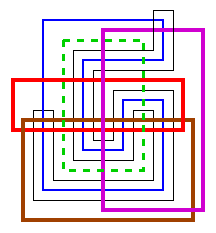

| THE ELECTRONIC JOURNAL OF COMBINATORICS 4 (1997), DS #5. |
Beyond what we've discussed in the preceding pages, there are many other aspects of Venn diagrams that have been considered in the literature. We mention some of these below.
We've already mentioned some geometrical concerns, such as congruent Venn diagrams, and diagrams made from specific curves such as circles, ellipses, triangles, and other polygons.
A Venn diagram is convex if the interiors of all its curves are convex. Note that the regions of a Venn diagram can alway be made convex, for example, by taking the Tutte embedding of the diagram. Grunbaum defines a stronger notion of convexity by insisting that not only are the curves convex, but also regions and the complement of the external region; we call this condition strong convexity.
A Venn diagram is exposed if each of its curves touches the
outer face at some point of non-intersection.
Note, for example, that the 3-Venn diagram #3.2 is not exposed, even
though all curves have a point of intersection on the outer face.
Stated in terms of n-Venn graphs, being exposed is
the same as the condition
that the vertex corresponding to the outer face has degree n.
Every symmetric Venn diagram must be exposed (obvious) and
every convex Venn diagram must be exposed
([Gr92a]).
A Venn diagram has a hidden curve if it has a curve that
does not touch the outer region.
For example, in Venn's general construction, curves 4,5,...,n-1
are all hidden.
Chilakamarri, Hamburger, and Pippert
[CHP96b] gave an example, shown below,
of a simple 6-Venn diagram which is not in the same class as
any exposed diagram.
The hidden curve is the dotted green one.

All simple Venn diagrams with five or less curves are exposed, but with five curves there are 8 (5 reducible, 3 irreducible) that do not have a convex drawing in the plane [CHP97a].
Recently, Hamburger and Pippert [HP96a] proved that there are simple reducible Venn diagrams with 5 congruent ellipses, in spite of the fact that Venn had stated that there are no such diagrams. In fact, there are two of them, but they are in the same class.
Let k-gon designate any convex polygon with at most k sides. Define N(k) to be the maximum number of curves in a Venn diagram whose curves are k-gons. Grünbaum [Gr75] proves that N(k) is asympotically lg(n) via a sqeezing argument, where lg denotes the base 2 logarithm. The upper bound uses a construction very much like Edwards' general construction, except that the circle is replaced by a square and the nth curve is a 2n-gon. Also, Grünbaum [Gr75, pg. 17] states that "the construction we used ... is a modification to convex polygons of the method described in Moor [Mo]."
Define K(n) to be the smallest k for which there exists a Venn diagram of K(n) curves, all of which are k-gons. Grünbaum [Gr75] contains a proof of the following theorem.
Theorem G. K(3) = K(4) = K(5) = 3, and K(6) <= 4.
The value of K(7) is unknown, but Grünbaum has constructed and independent family of 7 hexagons.
Grünbaum [Gr75] mentions several general geometric problems on d-dimensional diagrams where the sets are required to be boundaries of d-polytopes or convex regions.

| THE ELECTRONIC JOURNAL OF COMBINATORICS 4 (1997), DS #5. |